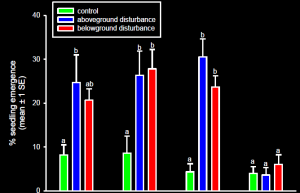An NCCOS-funded study found that the invasive non-native variety of the common reed Phragmites australis in the Chesapeake Bay estuary thrives around altered and hardened shorelines and disturbed marshes and beaches with elevated nutrients. The research team also concluded that native Spartina marsh plant communities will struggle under this invasion without management action.

The seven-year project investigated the impacts of shoreline hardening and showed how multiple environmental stressors and disturbances in the intertidal zone (e.g., excess nutrients, toxic substances, and shoreline alterations) facilitated the spread of invasive Phragmites. The researchers also found that the emergence of invasive Phragmites was influenced by the ability of resident plants and underlying environmental conditions to limit the success of the invader.

Without an effective management strategy, the non-native reed could potentially occupy all brackish and the majority of tidal freshwater wetlands. The researchers emphasized that management efforts should include restoration of native plant communities in addition to Phragmites eradication. The team also recommended prioritizing wetlands and watersheds to identify ecosystems that would benefit most from Phragmites management and where the negative impacts of management would be minimal.
Citation: Karin M. Kettenring, Dennis F. Whigham, Eric L. G. Hazelton, Sally K. Gallagher, and Heather M. Weiner. 2015. Biotic resistance, disturbance, and mode of colonization impact the invasion of a widespread, introduced wetland grass. Ecological Applications 25(2): 466 -480.
